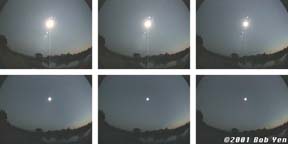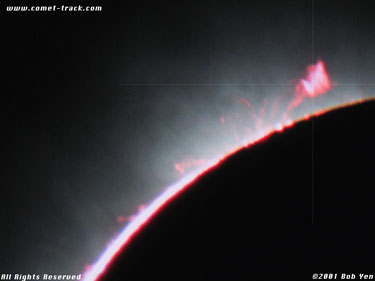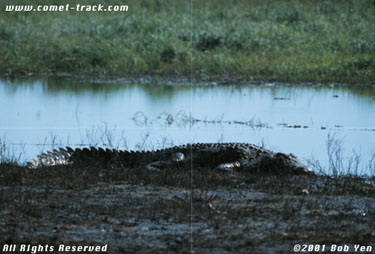| POWERED by |
|
WEBSITE servers |







 plant with bean-like fruit |
 tree with bean-like fruit |


 billboard in town, North of Lusaka |
 Mike Duncan's "extreme off-roader" Jeep (Burbank, CA) |
I arrived in Kabompo 1 day before E-day, on June 20th. The Kabompo river revealed itself as the desirable place to setup
an eclipse observation site. The immigration officer was contacted, & we went on a fact-finding trip.
The car-ferry was broken (not uncommon in Zambia), so the only option was canoe. At first, I thought that nixed any
chances of setting up on the eastern side of the river (to get a view of the west, with the river in the foreground).
However, it was clear the canoe was a very smooth & reliable operation: the oarman demonstrated clear expertise. We crossed
& found a suitable site along the banks of the Kabompo River. Permission from the property owner was granted, & we
went back to transport the > 200 lbs of gear. The local villagers were busy doing their chores:
 boy @Kabompo river-crossing |
 2 boys at village, across from Kabompo |
 main tracking platform: 2 corona cameras + prominence camera |
 observation site, viewed from island |
 loading equipment (200 lbs total) into canoe |
 equipment crossing the Kabompo River |
 loading ox cart with equipment |
 ox cart transport (from river, to observation site) |

Despite some equipment problems (whew, it was close!), my eclipse program went off reasonably
successfully.
 main equatorial mount & multiple-exposure tripod |
 camera control center |
I centered the sun in the 5" scope at ~1pm (30 minutes before 1st contact). The sun kept drifting out of the FOV (field of view), so something was wrong. (I interrupted this trouble-shooting, to start the CBL data-logger at 1:27:39 local time). I tried changing the azimuth on the GEM (german equatorial mount), but no go. I even disassembled the RA clutch, tightened it & the set-screw, still no go. Finally, 20 minutes before 2nd-contact (totality start), I realized I had the RA & Dec cables "reverse connected" to the mount!! I changed them to the correct configuration, & scrambled to catch up. Centered the 2 other scopes: prominence camera & backup 35mm corona camera. Another bug presented itself: the tangent assembly for the narrow-angle video camera didn't have enough travel, to center the sun! I used some tape to act as a shim, & the sun was in the bottom of the frame (at full zoom). I had to leave it (video is just an afterthought for my eclipse program, anyway), & go on. Then, another bug presented itself. The panorama platform was off by 90 degrees! (I fabricated an aluminum bracket at the last minute, at 3am on the morning of my departure flight. Because of sleep deprivation, it was misaligned by 90 degrees). I disassembled it twice, to correct it, but no go. I finally realized, I could put the horizon video-camera on the fixed tripod with the 7.5mm fisheye lens (unfortunately, it meant I couldn't do a spin-panorama with the video camera).
By this time, it was real close to 2nd contact, the light began to get very weird. Like being in a room, with a candle. The wheat fields around me, got real yellowish looking. (deja vu. Very much like Turkey in '99, where I was also in a wheat field). I scrambled, to mount the 3rd video camera to record shadow-bands. I re-centered the sun, & waited for 2nd contact. Because I was rushed (fearing I would miss 2nd contact), I spent too much film on 2nd contact. OTOH, I got a good long sequence for it. However, it had some long term effects: it prevented a good sequence for 3rd contact (but, I lost the wide-angle panorama for totality).

At the onset of totality, I noticed a bright pinkish-red prominence on the lower right. (reminiscent of the '98 eclipse, where the "bottle-like" prominence was noticeable during 2nd contact).

 frost accumulation on cameras, lenses, cases |
 note the dew on binoculars |
I quickly went thru my eclipse program: prominence camera to get chromosphere & prominences near 2nd contact. Then, a bracketed sequence on the main corona camera (1040mm on 120 format), then the backup 35mm corona camera.




I would rate my performance, a 7 on a scale of 1 to 10. I got most of my shots, but not all. I had to fight thru some nagging problems, but that's the "biz" of dragging a lot of hardware half-way across the world (to an isolated site). The fact that British Airways lost my 2nd check-in case on arrival to Lusaka, didn't help. (I noticed the green stickers by British Airways Security, so I assume they were concerned about my unusual looking Takahashi mount. It looks like a pipe-bomb! Possible IRA infiltrator?). It cost me an extra day of waiting, otherwise I would have been at the site 1 day earlier. Then, those bugs I ran into would have been fixed well in advance.
Right after 3rd contact, I'm sure I saw this large dark band coming towards me
over the river. It was very large scale shadow band? My 3rd video-camera, shows
rippling of very small scale shadow bands. I was completely oblivious to the
sounds around me, during totality. The video camera audio revealed chirping
crickets, a bird who was serenading very loudly, a cheering crowd (in the
background). The narrow-angle video also showed a cluster insects flying front
of the lens. The shadow-bands video camera, also showed these insects (& their
shadows). The narrow-angle video also showed these insects, mosquitoes? (they typically come out at dusk):

In a post-eclipse interview, the local farmers (Paul Makina & his relatives) gave me some interesting observations of the eclipse (I loaned them my 10x50 binoculars for viewing). They described a "rainbow", which is their description of the chromosphere at 2nd contact. They thought the corona had a yellowish hue (due to wavelength dependent atmospheric diffraction, there was a lot of bio-mass burning in Western Zambia). Deb Lein (observing across the river in Kabompo) thought the corona was a "bright white". Both, she & the local farmers noticed the shadow bands. Deb said that many of the locals hid-out in their houses for the eclipse (considered a bad omen, witchcraft), but came out after seeing the "rippling" shadow bands. Then, they took a look at the eclipse.
There was a funny scene after the eclipse. The local villagers were told by the village chief to stay away from my site (during eclipse), so I could work undistracted. After the eclipse, there was a large crowd of curious onlookers. (It reminded me of a Twilight Zone episode, where townspeople were gazing at some extra terrestials). I was told, they were talking about me the day before the eclipse. They thought my equipment, reminded them of the Apollo Moon Landing (in the late 60's). So, they thought I was an "astronaut".


I was working closely with many expeditions, & many scientists. Including Dr. Jay Pasachoff's Lusaka group (who coordinated his ground-based data with SOHO images), Dr. Glenn Schneider's (Univ of Arizona astronomer) group at Lower Zambezi Park, Dr. Barrie Jones (Open University, UK). Weather was the primary concern, so weather reports & communication (via satellite-phone & sat-phone email) was crucial.
I contacted Lt. Colonel Davies Ngambi (head, meteorological center in Lusaka), & connected him with Dr. Pasachoff, for near E-day weather reports.
 Lt. Col. Davies Ngambi briefing me on weather |
 Dr. Jay Pasachoff briefing his group on 6/15 (overcast!) |
I just got back a few hrs ago. Whew! what an eclipse & what an adventure.
I worked closely with Daniel Fischer's German group, whose research 2 weeks before E-day proved invaluable (THAT's the way to approach an eclipse: thorough research. German precision! Click HERE for their official report). I had a strategy meeting on 6/14 to discuss logistics & weather at ZASTI (Lusaka). 3 days later (6/17) I met them at Lochnivar National Park, just as they were leaving (I was arriving). That morning, we were both nightsky observing, within a few km of each other. We met a 3rd time, on 6/28, since we had the same return flight (British Airways Flight #283) back to London Gatwick. We shared experiences, videos (after organizing our respective "offices". Man, was there was a lot of material to straighten out!).
 Daniel Fischer visiting my seat (row 38), he was only a few rows up |
 Playing eclipse video, on his new Canon MV 330i (ZR10 in USA) mini-DV |
 German group @Kafue Park, nice setup |
 Daniel Fischer's group at Lochnivar National Park (6/17) |
I also ran into SEML member Cees Bassa (physics grad
student in Netherlands) at a road block south of Lusaka. We
were both on our way to Livingstone. Before E-day, I met Dr. Jay Pasachoff (Williams College) & Olivier Staiger (High Noon live webcast) at
Hotel International in Lusaka. We firmed up our communication channels, to exchange weather reports near E-day.

Clouds were a problem 1 week before E-day, in Lusaka. On arrival to Lusaka (6/14, Thursday), I immediately encountered 2 problems. Number 1, there were lots of scattered clouds (bad weather is not good for an eclipse).
 scattered clouds on arrival in Lusaka on 6/14 (11am) |
 greeting sign, just before Immigration @Lusaka Int'l Airport |
 billboard advertisement @Manda Hill, using eclipse image |
 packing up supplies, after night of bushcamping (nighttime sky viewing) |
We traveled 1st to Lochnivar National Park (south of Lusaka) for sightseeing, so we could go back north for a weather update closer to E-day. The pictures below depict a scene repeated throughout my Zambia outback travels: stop-and-go visits with villagers (the Real Africa!)...
 approaching a village, just outside Lochnivar National Park... |
 ...curious villagers checking-out the visitor... |
 ...always an inquisitive smile... |
 ...waving good-bye, after the stop-and-go visit |
 curious villagers, outside Lochnivar National Park |
 Mr. Ngambi looking at satellite imagery & weather forecasts |
 filling 5 gallon petrol cans (3 spares): real off-roading! |
 eclipse coverage on Zambian TV (European eclipse chasers) |
 Mr. Gilbert showing me ZNTB eclipse brochures |
 Mr. Gilbert wearing official ZNTB eclipse t-shirt |
I finally arrived at Kabompo, it was dominated by the very obvious Kabompo River. I found out there were some German eclipse-chasers, staying at a house. The ferry (for cars) was broken, so 200lbs of equipment was transferred by canoe! (then, by ox-cart to the site) Not a problem, it was fun. I made friends with the local farmers, who owned & farmed the islands (see pictures). There was a canoe dock near my site (30 yards away):
 oxcart 4x4? (2 oxen = 2 sets of 4-hoofs) |
 ox carts are simple, but effective means of transport |
 sunflower on island (resembles the radially symmetric solar eclipse corona) |
 canoe dock at sunset |
 beehive in Musombu tree (closeup) |
 anthive colony (in Musombu tree) |
 beehive in Musombu tree (wide view) |
 the Musombu tree containing beehive bears a green fruit |
 harvested honey (being taken across the river to Kabompo) |
 Paul Makina (& farmers) "scoping" the houses across the river |
 canoeing on the Kabompo River |
 Deb Lein briefing us (on eclipse & road conditions) |
 steam off the (warm) Kabompo River, in early AM (cold air) |
 lone canoeist on the Kabompo River |
 bush with pale-red flower |
 termite hills all over the place (big ones!) |
Nighttime astrophotography & Southern Sky viewing was done on 10
nights. I
actually remember THAT, more than the eclipse..and the eclipse itself
was
phenomenal! (I tracked Comet A2 Linear & saw it brighten considerably.
saw it on the morning I left, the 28th. Mad dash back to
Lusaka to catch my flight!! Crazy. I even lost my ticket to London!).
Mars & Sagittarius near the zenith. Unreal. The entire Northern Cross
&
Vega (Cygnus) was still visible, as part of the Milky Way stretched
horizon
to horizon. Saw a ton of meteors. Even saw a -1 magnitude meteor, with
persistent train. The zodiacal light was awesome. (Never saw it from
35
deg north).
 AP 5.1" f8 EDT APO @Monze site, sunrise |
 piggyback telephoto setup @Mufumbwe site |
 2 check-in cases, for astro-equipment |
 camera & lens equipment |
 very noticeable zodiacal light, extending high above the western horizon |
 sunset w/moon over Ihaha camp (Chobe Nat'l Park), prior to nightsky session |
 small bush w/red leaves (fall colors were prevalent everywhere) [ Kazangula, Zambia (near Botswana border) ] |
 bug on tree (well camouflaged) [ Kazangula, Zambia (near Botswana border) ] |
 thistle being pollinated by ants [ Kazangula, Zambia (near Botswana border) ] |
 tree with bean-like fruit [ Kazangula, Zambia (near Botswana border) ] |
 new growth, in "biomass burn" area [ Mufumbwe, Zambia (near Congo border) ] |
 termite eating our boxes (they dug channels overnight!) [ Mufumbwe, Zambia (near Congo border) ] |


 hailstones, as large as 3/4" in diameter |
 Italian photographers getting pelted by hail |
 closeup view of Victoria Falls |
 Ultralight aircraft, waiting for passenger |
 butterfly at Victoria Falls |
 the infamous Black Mamba (deadly poisonous) |
 foodstand selling bananas & cooking oil |
 workers in Livingstone |
Dew was a real problem, used matches to burn off dew from lenses.
Really
hampered astrophotography. I even got frost on my equipment, it got so
cold in the AM, 40's (it's winter down there). mid-80s & toasty during
the
day. Food was great, no stool problems. People were real friendly,
polite.
 onlooker @Kabompo river-crossing |
 brother & sister, @village across Kabompo River |
 gregarious kids greeting me with: "how are you?" [ on the way to Kabompo (near Congo border) ] |
 onlooker watching us load the canoe w/equipment [ @Kabompo river-crossing ] |
 Mr. Katombo, owner of restaurant in Kabompo |
 visitor at restaurant |
 man & son (Kabompo river-crossing) |
 boy with pick-axe (Kabompo river-crossing) |
 2 women waiting to cross Kabompo River (by canoe) |
 boy carrying load (W. Zambia, near Congo Border) |

Travel in Zambia invokes memories of..potholes! Every size imaginable: small, medium, big, huge. Hitting a nasty pothole at speed will result in: flat tire, bent rim, or bad accident (in that order). The roads after Solwezi, were all dirt (they are marked as hiways on the map). Certain stretches were slow going (10mph), because of deep cross-grain ditches. (up to 1 feet deep). There are lots of people walking on the roadside. Lots of overloaded trucks, with people or cargo. Constantly seeing "biomass fires": smoke in the distance & ocassionally fires by the roadside.
 lines of people in early AM, walking to work |
 disabled truck on the highway |
 truck loaded w/cargo & people |
 biomass fire, in the distance |
 jack-knifed truck |
 this car collided with the truck |
 truck-driver & passenger |
 thumbs up from a traveler |
Wildlife viewing was one of the highlights of the trip. I decided to try Chobe National Park (Botswana), on advice from Deb Lein (volunteer US teacher in Kabompo). We crossed the Chobe River, via pontoon boat:
 ferry crossing to Botswana (Chobe River) |
 Greyson Sulu & his S. African friend |

 baby elephant grazing in trees |
 water buck surveying the safari 4x4 |


Food was great. I patronized a fast-food place called "Eat Now" many times, located in Mazabuka (south of Lusaka). It had some great grilled chicken, 9 pieces for 9000 Kwacha (~$2.50)! My driver Greyson Sulu took me to a *real* Zambian restaurant, in Livingstone.
 Beef w/Nshima 3500 Kwacha (~$1.00) |
 eating at table, with Greyson Sulu |
I wrapped up my trip by a nighttime observing run at Monze, on the day of my return flight (!). Comet A2 Linear was looking brighter, very noticeable naked-eye (more so, than when I arrived 2 weeks ago). I had to dash back to Lusaka, & picked up some souveneirs on the way:
 incredible artwork, those giraffe carvings |
 beautiful animal carvings (teakwood & other wood) |
 London Heathrow terminal (my plane to LAX is on far right) |
 all luggage returned promptly & safely @LAX (waiting for taxi, to go home) |
I totally fell for Africa, will probably go there for 2002 eclipse in December. I got a safari tour in Chobe Nat'l Park (eclipse path 2002 crosses there), & the operator filled me in on weather patterns in December. I think it's do-able, but one has to be VERY MOBILE to dodge bad weather (rainy season).